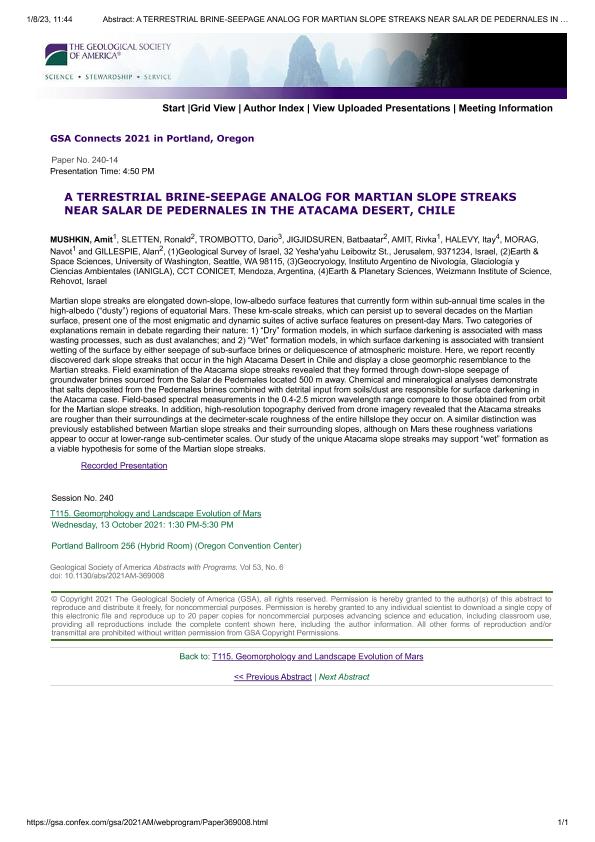Mostrar el registro sencillo del ítem
dc.contributor.author
Mushkin, Amit
dc.contributor.author
Sletten, Ronal
dc.contributor.author
Trombotto, Dario Tomas

dc.contributor.author
Jigjidsurengiin, Batbaatar
dc.contributor.author
Amit, Rivka
dc.contributor.author
Halevy, Itay
dc.contributor.author
Morag, Navot
dc.contributor.author
Gillespie, Alan R.
dc.date.available
2023-11-28T18:32:47Z
dc.date.issued
2021
dc.identifier.citation
A terrestrial brine-seepage analog for Martian slope streaks near Salar de Pedernales in the Atacama Desert, Chile; The Geological Society of America: Connects 2021; Oregon; Estados Unidos; 2021; 1-1
dc.identifier.uri
http://hdl.handle.net/11336/218720
dc.description.abstract
Martian slope streaks are elongated down-slope, low-albedo surface features that currently form within sub-annual time scales in the high-albedo (“dusty”) regions of equatorial Mars. These km-scale streaks, which can persist up to several decades on the Martian surface, present one of the most enigmatic and dynamic suites of active surface features on present-day Mars. Two categories of explanations remain in debate regarding their nature: 1) “Dry” formation models, in which surface darkening is associated with mass wasting processes, such as dust avalanches; and 2) “Wet” formation models, in which surface darkening is associated with transient wetting of the surface by either seepage of sub-surface brines or deliquescence of atmospheric moisture. Here, we report recently discovered dark slope streaks that occur in the high Atacama Desert in Chile and display a close geomorphic resemblance to the Martian streaks. Field examination of the Atacama slope streaks revealed that they formed through down-slope seepage of groundwater brines sourced from the Salar de Pedernales located 500 m away. Chemical and mineralogical analyses demonstrate that salts deposited from the Pedernales brines combined with detrital input from soils/dust are responsible for surface darkening in the Atacama case. Field-based spectral measurements in the 0.4-2.5 micron wavelength range compare to those obtained from orbit for the Martian slope streaks. In addition, high-resolution topography derived from drone imagery revealed that the Atacama streaks are rougher than their surroundings at the decimeter-scale roughness of the entire hillslope they occur on. A similar distinction was previously established between Martian slope streaks and their surrounding slopes, although on Mars these roughness variations appear to occur at lower-range sub-centimeter scales. Our study of the unique Atacama slope streaks may support “wet” formation as a viable hypothesis for some of the Martian slope streaks.
dc.format
application/pdf
dc.language.iso
eng
dc.publisher
The Geological Society of America
dc.rights
info:eu-repo/semantics/openAccess
dc.rights.uri
https://creativecommons.org/licenses/by-nc-sa/2.5/ar/
dc.subject
Martian slope streaks
dc.subject
Atacama
dc.subject
Desert
dc.subject
Salar de pedernales
dc.subject.classification
Geociencias multidisciplinaria

dc.subject.classification
Ciencias de la Tierra y relacionadas con el Medio Ambiente

dc.subject.classification
CIENCIAS NATURALES Y EXACTAS

dc.title
A terrestrial brine-seepage analog for Martian slope streaks near Salar de Pedernales in the Atacama Desert, Chile
dc.type
info:eu-repo/semantics/publishedVersion
dc.type
info:eu-repo/semantics/conferenceObject
dc.type
info:ar-repo/semantics/documento de conferencia
dc.date.updated
2022-11-04T15:37:09Z
dc.journal.volume
53
dc.journal.number
6
dc.journal.pagination
1-1
dc.journal.pais
Estados Unidos

dc.journal.ciudad
Oregon
dc.description.fil
Fil: Mushkin, Amit. Geological Survey of Israel; Israel
dc.description.fil
Fil: Sletten, Ronal. University of Washington; Estados Unidos
dc.description.fil
Fil: Trombotto, Dario Tomas. Consejo Nacional de Investigaciones Científicas y Técnicas. Centro Científico Tecnológico Conicet - Mendoza. Instituto Argentino de Nivología, Glaciología y Ciencias Ambientales. Provincia de Mendoza. Instituto Argentino de Nivología, Glaciología y Ciencias Ambientales. Universidad Nacional de Cuyo. Instituto Argentino de Nivología, Glaciología y Ciencias Ambientales; Argentina
dc.description.fil
Fil: Jigjidsurengiin, Batbaatar. University of Washington; Estados Unidos
dc.description.fil
Fil: Amit, Rivka. Geological Survey of Israel; Israel
dc.description.fil
Fil: Halevy, Itay. Weizmann Institute Of Science.; Israel
dc.description.fil
Fil: Morag, Navot. Geological Survey of Israel; Israel
dc.description.fil
Fil: Gillespie, Alan R.. University of Washington; Estados Unidos
dc.relation.alternativeid
info:eu-repo/semantics/altIdentifier/url/https://gsa.confex.com/gsa/2021AM/webprogram/Paper369008.html
dc.relation.alternativeid
info:eu-repo/semantics/altIdentifier/doi/http://dx.doi.org/10.1130/abs/2021AM-369008
dc.conicet.rol
Autor

dc.conicet.rol
Autor

dc.conicet.rol
Autor

dc.conicet.rol
Autor

dc.conicet.rol
Autor

dc.conicet.rol
Autor

dc.conicet.rol
Autor

dc.conicet.rol
Autor

dc.coverage
Internacional
dc.type.subtype
Congreso
dc.description.nombreEvento
The Geological Society of America: Connects 2021
dc.date.evento
2021-10-10
dc.description.ciudadEvento
Oregon
dc.description.paisEvento
Estados Unidos

dc.type.publicacion
Journal
dc.description.institucionOrganizadora
The Geological Society of America
dc.source.revista
Geological Society of America Abstracts with Programs
dc.date.eventoHasta
2021-10-13
dc.type
Congreso
Archivos asociados
